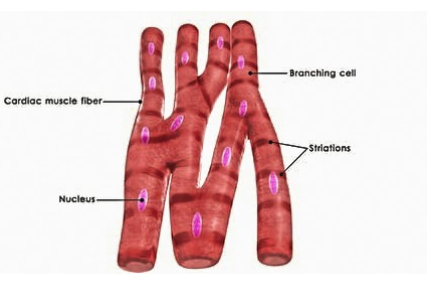
Answer
467.7k+ views
Hint: They are also known as the heart muscles as these muscles are present in the heart of our body.
Cardiac muscles are known as the heart muscles or myocardium.
Cardiac muscles are one of the three types of vertebrate muscles.
Complete answer:
Features of cardiac muscles
>The cardiac muscles are involuntary in function, their functioning cannot be controlled by humans. >They are involved in continuous rhythmic contraction and relaxation of the heart.
>Cells of cardiac muscles called cardiomyocytes are uninucleate (single nucleus), cylindrical, elongated, striated, and branched.
>The cardiac muscles if damaged have no regenerative capacity.
Additional information:
>The cardiac muscles are myogenic which means the contractions are generated within the muscles.
>Cardiac muscles have striations due to the presence of actin and myosin filaments which are arranged into sarcomeres.
>These muscles are joined to one another by intercalated discs that contain gap junctions.
>These Intercalated discs have proteins that allow direct transmission of current from cell to cell across the chambers of the heart so that the cells contract altogether.
>It helps in coordinated muscle contraction and maintenance of circulation.
>Cardiac muscles resist fatigue so well because it has got more mitochondria than other muscles. >Mitochondria continuously provides energy resulting in the heart never stopping until a person dies.
>The beating of the heart is triggered by an electrical impulse.
>The impulse starts in a small bundle of specialized cells located in the right atrium, called the SA (sinoatrial) node which is the heart's natural pacemaker.

Note: Vertebrate body consists of three types of muscles: skeletal muscles (striated, voluntary, unbranched, and multinucleate), smooth muscles (non-striated, involuntary, uninucleate and branched) and cardiac muscles.
Cardiac muscles are known as the heart muscles or myocardium.
Cardiac muscles are one of the three types of vertebrate muscles.
Complete answer:
Features of cardiac muscles
>The cardiac muscles are involuntary in function, their functioning cannot be controlled by humans. >They are involved in continuous rhythmic contraction and relaxation of the heart.
>Cells of cardiac muscles called cardiomyocytes are uninucleate (single nucleus), cylindrical, elongated, striated, and branched.
>The cardiac muscles if damaged have no regenerative capacity.
Additional information:
>The cardiac muscles are myogenic which means the contractions are generated within the muscles.
>Cardiac muscles have striations due to the presence of actin and myosin filaments which are arranged into sarcomeres.
>These muscles are joined to one another by intercalated discs that contain gap junctions.
>These Intercalated discs have proteins that allow direct transmission of current from cell to cell across the chambers of the heart so that the cells contract altogether.
>It helps in coordinated muscle contraction and maintenance of circulation.
>Cardiac muscles resist fatigue so well because it has got more mitochondria than other muscles. >Mitochondria continuously provides energy resulting in the heart never stopping until a person dies.
>The beating of the heart is triggered by an electrical impulse.
>The impulse starts in a small bundle of specialized cells located in the right atrium, called the SA (sinoatrial) node which is the heart's natural pacemaker.

Note: Vertebrate body consists of three types of muscles: skeletal muscles (striated, voluntary, unbranched, and multinucleate), smooth muscles (non-striated, involuntary, uninucleate and branched) and cardiac muscles.
Recently Updated Pages
Identify the feminine gender noun from the given sentence class 10 english CBSE

Your club organized a blood donation camp in your city class 10 english CBSE

Choose the correct meaning of the idiomphrase from class 10 english CBSE

Identify the neuter gender noun from the given sentence class 10 english CBSE

Choose the word which best expresses the meaning of class 10 english CBSE

Choose the word which is closest to the opposite in class 10 english CBSE

Trending doubts
Sound waves travel faster in air than in water True class 12 physics CBSE

A rainbow has circular shape because A The earth is class 11 physics CBSE

Which are the Top 10 Largest Countries of the World?

Fill the blanks with the suitable prepositions 1 The class 9 english CBSE

One Metric ton is equal to kg A 10000 B 1000 C 100 class 11 physics CBSE

How do you graph the function fx 4x class 9 maths CBSE

The Equation xxx + 2 is Satisfied when x is Equal to Class 10 Maths

Give 10 examples for herbs , shrubs , climbers , creepers

Change the following sentences into negative and interrogative class 10 english CBSE




